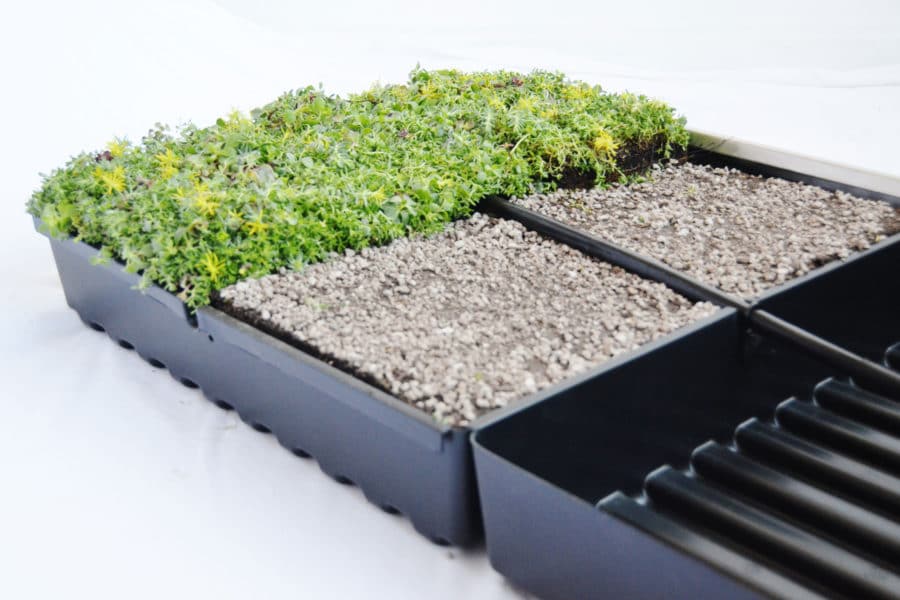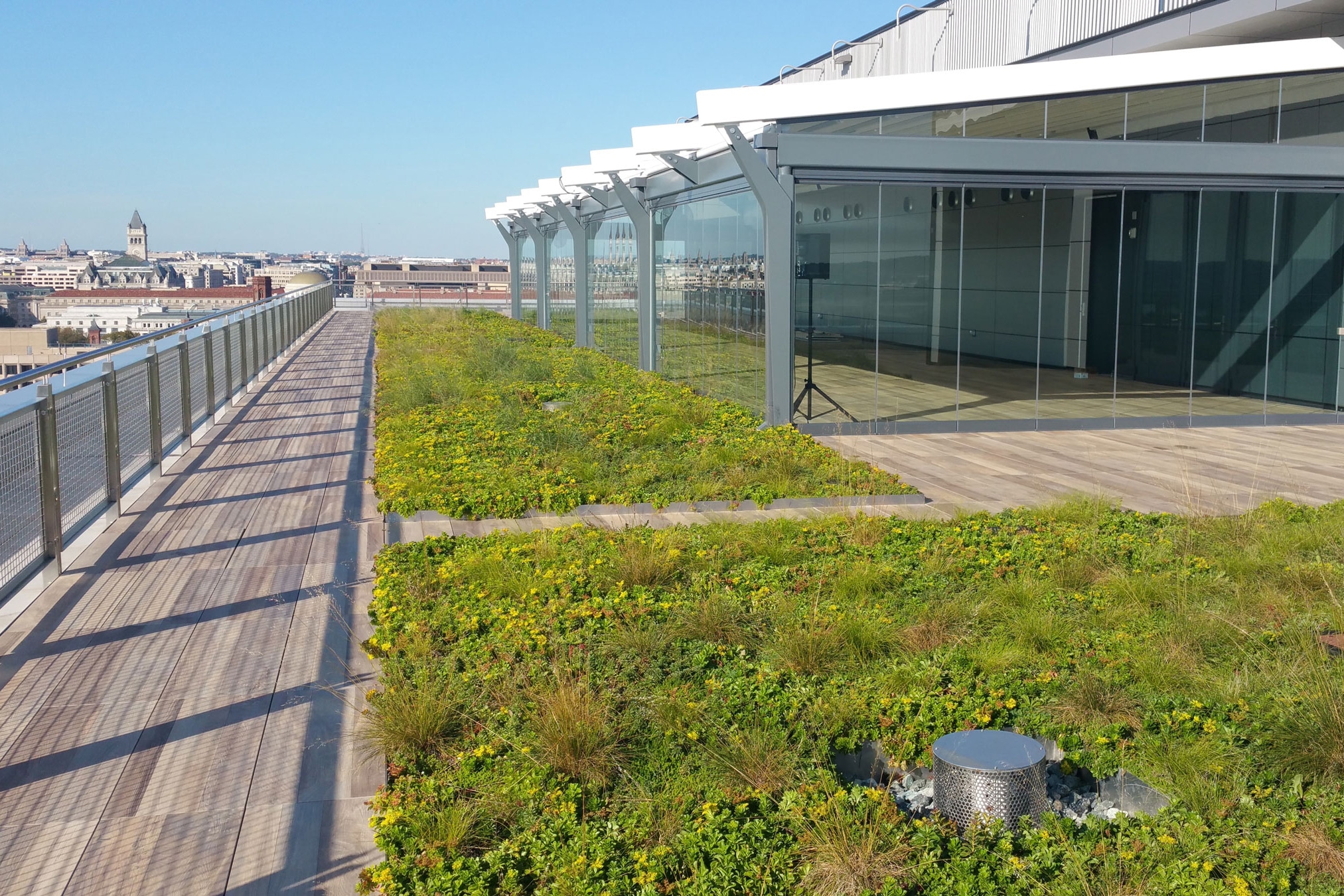Story at a glance:
- Sedum roofs contain shallow-rooted, drought-tolerant succulents.
- With proper installation, sedum roofs are low-maintenance and pollinator-friendly.
- Sedum roofs help regulate interior building temperatures, resulting in energy savings and reducing the urban heat island effect.
With sustainable roof laws popping up around the world, designers and builders are exploring living roofs composed of green plants for their multiple benefits.
For instance, a New York modeling study concluded that only a 50% green roof cover in the city would lower surface temperatures up to 0.8ºC. For every degree reduction, 495 million KWh of energy could be saved. After data analysis, Toronto officials reached similar conclusions and enacted their Green Roof Bylaw.
A sedum roof may be an excellent green roof option for many buildings.
What is a sedum roof?
A sedum (stonecrop) roof is a type of extensive green roof, not to be confused with other types of green roofing. A sedum roof showcases only plants of the genus sedum that are adapted to regional climatic conditions, contains a thin (2- to 6-inch) layer of growing medium (substrate), is lightweight, requires minimal maintenance, and has low installation costs.
Sedum roofs do not need irrigation, except possibly the first few weeks until plant root systems are established. They are not meant to be walked on. Sedum roofs are distinct from rain gardens containing a wide variety of plants and shrubs often growing in irrigated soil mixes.
“The European model of more lightweight, shallow soil, easier to maintain extensive systems have been gaining popularity in the US in the past decade due to cost and design advantages,” said Sika Sarnafil’s John Robinson in a previous interview for gb&d.
What are the layers in a sedum roof?
Many commercially available sedum mats resembling sod blankets are installed onto roofs. These mats consist of a base layer of polyester or a similar fabric. A 1-inch layer of growing medium is put on top. Then sedum seeds or transplants are spread over it and eventually take root.
When ready for installation, the sedum mats are rolled out onto a green roofing system composed of multiple layers, each with a distinct function. These are:
1. Roof (typically asphalt shingles on wood; a metal roof may work, but it’s controversial)
2. Moisture-trapping barrier
3. Thermal insulating layer
4. Waterproofing membrane (root barrier)
5. Drainage layer
6. Filtering layer
7. Growing medium (substrate)
8. Plants
If designers are wondering whether pre-grown, modular sedum mats are preferable over seeding on a rooftop, one study concluded that sedum mats are more effective at retaining stormwater than sedum roofs seeded at the time of installation.
What are the best plants for a sedum roof?

Plant trays from Archatrak. Photo courtesy of Archatrak
There are more than 600 species of flowering plants in the genus Sedum—a group of succulents possessing a stunning array of flowers and foliage in varied shapes, sizes, and colors. Most sedums are found throughout rocky, mountainous terrain in the northern hemisphere.
Sedums are popular on living roofs because they are extremely sun-, wind- and drought-tolerant. In fact, research shows that some sedum species survive after four months without water.
“Desert plants like cacti and succulents have evolved to conserve water by transpiring less than other plants … Plants in arid regions have developed various strategies to survive droughts by conserving water. These adaptations include shedding leaves, reducing leaf size and number, limiting branching, and developing hard leaves that can withstand wilting,” says Anna Zakrisson, biologist, cofounder, and chief science officer of iimpcoll, in a previous article for gb&d.
Zakrisson described the special future of plants, including sedums, in the Crassulaceae family: “CAM (Crassulacean Acid Metabolism) plants, like succulents and cacti, have developed a completely different approach to photosynthesis. These plants open their stomata at night and store carbon dioxide in the form of malate, a four-carbon compound. During the day when their stomata are closed, CAM plants utilize the stored carbon for photosynthesis. This unique adaptation allows them to conserve water in arid environments, making them an excellent choice for xeriscaping and water-wise garden designs.”
It’s always best to choose sedums that are native to your area because those will be most likely to thrive on a rooftop there. To attract pollinators, straight (non-cultivar) species are best. In many cases cultivars will also be acceptable food sources for bees, moths, and other pollinators. Research is ongoing in this area. A major conclusion thus far from studies is that cultivars with red or purple leaves are not effective substitutes for the straight species.
What are the advantages of a sedum roof?
There’s a multitude of advantages to a sedum roof. Here are the major ones.
1. When installed by an experienced and knowledgeable professional, sedum rooftops are low-maintenance and low-cost compared to other living roof systems.
2. Besides energy savings, sedum roofs are aesthetically pleasing and contribute to biodiversity especially in nature-deprived urban areas.
3. Sedum roofs will meet local sustainability laws as a form of green infrastructure.
4. Sedum roofs are eligible for LEED credits.
“Nature-based solutions such as planting trees, adding green roofs and walls, maintaining natural river systems, and implementing coastal-based storm surge protection like mangroves and wetlands to combat storm surges can have a significant effect on cities. At the same time these additions provide other benefits such as cooling the street level, adding pleasurable biophilic elements to our hardscapes, and making our cities livable,” Charlene Mortale, division vice president of project management at greenscreen, previously wrote for gb&d.
What are the disadvantages of a sedum roof?
There are a few disadvantages of sedum roofs.
1. Sedums require dry soil conditions and sun, so cloudy regions with heavy, regular rainfall are not sedum-adaptive.
2. Flat and low-pitched roofs are ideal. It’s possible—although challenging—to succeed at higher pitches. Consult an expert to be sure.
3. Sedum roofs have a greater upfront cost compared to conventional roofing systems.
“While the initial cost of a vegetative roof can sometimes be two to three times the cost per square foot of a traditional roof system, there is a wide range of application options that can work for different budgets. In addition, people typically focus on upfront cost instead of considering the total life cycle of the roof. A traditional exposed roof might only last 15 to 20 years, whereas a protected, covered, vegetative system could last in excess of 50 years. It is important that you have policy and code officials that are educated on green roof systems and any stormwater credits or other grants that may be available to someone constructing a green roof,” Robinson told gb&d.

